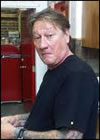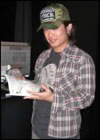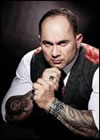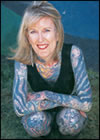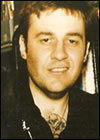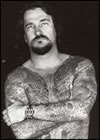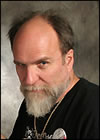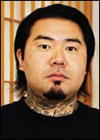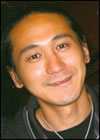|
|
|
|
|
Tattoo Chronicles << 101 Most Influential People in Tattooing << #60-#51 |
Top 101 Most Influential People in Tattooing
Well, so far so good. People are still talking to me. Maybe they think they’re still being considered for the Top 101 List and it wouldn’t be good to rock my boat. The fact is, the Top 101 List is one hundred and one, no more, no less. It’s simple mathematics, there’s about two hundred and fifty thousand tattoo artists, in the U.S. alone, give or take a few thousand, so all but one hundred and one of them will be excluded. All but one hundred and one will, potentially, be miffed. I totally understand. Even if there were a list of the Top 101 Carnival Geeks (you know, those guys who bite the heads off of chickens), and I wasn’t on it, I’d feel horribly left out, abandoned, totally rejected by my peers… and I wouldn’t bite the head off a chicken for a million bucks. Ozzy Osbourne did it on stage once (and has the million bucks to show for it), but not me. No matter. If there were a list of the Top 101 Chicken Head Biter Offers, I’d want to be on it. It’s human nature. The truth is, most of the people on this 101 Most Influential People in Tattooing list are there because I’ve had actual relationships with them during my fifteen years in the tattoo magazine business. I can pretty much say that everyone, from number 101 down to the coveted el numero uno, have either had a beer with me, been part of a mutual tattoo experience or were the subject of an article that I wrote or edited. That’s a good thing. One of the best parts of being a magazine editor, in fact. But as good as that is, a lot of people in this ever-expanding industry have never crossed my path. So, as good an artist as someone might be, or as essential as they are to the development of tattoo art in the U.S. or Canada or Asia or Europe or Polynesia or South America, our paths might never have crossed. To those artists, collectors and historians that I may have missed or overlooked, I apologize, hope you understand and trust that you will be included in our next list, whatever and wherever that might be. —Bob Baxter  |
|
60. Greg James’ (www.tattoosdeluxe.com) story unfolds, when he was fourteen. He drew flash for his brother, Tennessee Dave, at Captain Jim’s Trade Winds, Seven Seas and 362 on the Pike, in Long Beach. Then, it was six years at Good Time Charlie’s in Whittier. “Basically, I was working in East L.A., doing single-needle black-and-gray. I wasn’t very excited about it. I felt I was doing mediocre work, and I wanted to do superlative work. So, I made a choice. I would either quit tattooing or try to get in with Cliff Raven at Sunset Strip Tattoo. Cliff hired me. That’s the beginning of the story.” The original Sunset Strip tattoo was situated in an area famous for its clubs. The old Ciro’s was right across the street. Everybody waiting for a limo saw the tattoo shop. Opened in the 1960s by Lyle Tuttle and sold to Cliff Raven, Sunset is about two miles east of the original location. Although many people think it’s Greg’s shop, Robert Benedetti is the owner. Greg is simply it’s superstar employee. “It’s much more freeing that way,” explains Greg. “I can just do my work, without the headaches. About eleven months after I got hired, Cliff sold the shop to Robert. And Robert continued teaching me. He taught me about the craft of tattooing: the artwork, placement, what looks good. Since then, my style just keeps evolving. I keep polishing it, you might say. Traditionally, when you are apprenticed by a Japanese artist, you learn his designs. There is not very much variation. Over here, it’s different. I don’t believe there are rules. I do it like I see it. I focus more on the subject matter than the background, opposed to a Japanese tattoo where it’s very background heavy, very dark. I try not to be so dark and so traditional. I don’t really follow any rules.” Universally acknowledged as one of America’s finest tattoo artists, I asked Greg to give his appraisal of the current tattoo scene—what he thought of the countless new shops and self-proclaimed hotshots entering the scene. “I really haven’t been concerned with what’s going on around me,” he said. “I just enjoy what I’m doing.” And that’s why Greg James is on the list: he sets a great example, by constantly improving his technique, rising to the top of his craft and, essentially, minding his own business. |
|
59. Sabado (www.lovesabado.com) is an important member of the first generation of tattooers to experience a shift in sentiment about traditional Japanese art. As American-style tattooing gained popularity among the youth in Japan, the initial enthusiasm was met with resistance. In a society that questions individuality and values conformity, tattooing contradicts some of Japan’s basic ground rules. More and more, however, the youth of Japan began turning to the West for ideas about their identity, self gratification and fulfillment. Because of this rift, young Japanese artists began seeking inspiration from around the globe, instead of working with uniquely Japanese material. When Sabado was nineteen years old, he worked for the Sony corporation as a technical draftsman. He did not like the work and decided to travel. He first went to the United States, bought a Honda 500cc motorcycle in Los Angeles and decided to look for Route 66, the old, historic continental highway. That was 1987. He then sold the motorcycle in Houston, Texas, and, traveling by himself, took a bus to Mexico, down along the coast of the Gulf through the Yucatan to Guatemala, Nicaragua and El Salvador. In Guatemala, he met some guys who wanted to travel down the Amazon River. It was the rainy season, so they decided to wait for the dry season. Sabado went back to Japan and spent three months in Yokohama working for Nissan Motors on the assembly line. He made some money and then returned to Peru, to float down the Amazon on the raft, but it got to be too much. Every day it was the same thing—sitting on the raft, fishing. It got boring, se he ended up in Brazil. On the borders of Argentina, Paraguay and Brazil, he met a fellow who had some beautiful tattoos, and asked who did them. He answered, “An artist named Russo, in Rio de Janeiro.” So, Sabado said to himself, I want to meet this guy. Sabado was twenty-three years old. He continued to travel around South America, almost to Antarctica, ending up in Rio, where he decided to look for Russo. “I visited him almost every day at his home,” said Sabado. “We decided to put together a mobile tattoo shop. We would drive around and park our tattoo shop in areas where young people would hang out. We did a lot of tattoos. A lot of small designs from catalogs. At the end of that summer, things got slow, so I moved on to Sao Palo. I worked during the day at restaurants to make money and tattooed a little at night. In Sao Palo, I saw a Japanese magazine that had a feature about tattooing in Japan. I had no idea that it was getting popular, but I thought to myself, Maybe I can do it better than that. So I went back to Japan and slowly started to concentrate on tattooing. I started by traveling to people’s houses. Then, little by little, I developed a reputation through word-of-mouth, and decided to get an apartment in Nagoya. Each tattoo I did, I put the money together to buy what I needed for a tattoo shop. One tattoo—I bought a chair. The next tattoo—I bought a desk. The next—I bought a TV. More and more people came to my apartment looking for me, and, after a year, I finally had to open my shop. Sabado’s circuitous route to becoming a tattoo artist—one of the best I have ever seen, by the way—has resulted in a style that is uniquely his own. Based on Japanese and traditional American flash themes, his images are always surprising, always inventive and consistently unique. Maybe it’s his rebellious nature, maybe it’s his artistic wanderlust; in any case, nobody tattoos like Sabado. Nobody. |
|
58. Stephane Chaudesaigues (www.stephanechaudesaigues.com) was one of the first tattoo artists to attempt mural-sized, photographically precise tattoos. Good Time Charlie Cartwright, Jack Rudy, Freddy Negrete and Brian Everett began crafting lifelike portraits in black-and-gray, back in the late ’70s, but no one, until Chaudesaigues came onto the scene, was doing full gangster-themed backpieces, complete with speeding getaway cars, bad guys with fedora hats and machine guns blasting. His “Le Cinéma d’ Angel” tattoo, for example, is a chin-to-navel chestpiece built upon an oversized film strip bordered by lifelike portraits of various movie industry character actors. His Depression-era gangster backpiece features various miscreants staring unmercifully at you, the viewer, seemingly sizing you up for a well-placed gunshot or violent shakedown. Looking more like a shopkeeper or accountant than a rock-status tattoo artist, the balding, well-groomed man from Avignon is responsible for bringing a Japanese sensibility of diorama art mixed with a technical mastery for replicating the subtle nuances of photojournalistic art. His scenes incorporating well-known celebrities into the scenario, for example, are always spot on. It is because of artists like Stephane Chaudesaignes that tattooing has grown from a back-street, carnival oddity to a respectable craft that, especially since his arrival on the scene, is considered by many to qualify as museum-quality art. |
|
57. Tin-Tin (www.tin-tin-tattoos.com) is, without a doubt, the most famous French tattoo artist. His two shops are located in Paris at Rue Saint-Sébastien and Rue de Douai. “Tattooing, for me, is a passion,” he says. “It is my life. I like what I do and I do it right.” Tin-Tin is controversial, like all artists who are blessed with a great talent. In 1986, Tin-Tin started a tattoo shop in Toulouse, but he made his first tattoo two years earlier in Berlin, during his military service. He stayed in Toulouse for six years and returned to Paris a decade or so ago. “When I started tattooing, I didn’t start in the usual way,” he says. “Everybody begins with copying flash designs, doing the traditional tattoos. My starting point was not the flash of Spaulding and Rogers, but paintings and art books. I was copying like everyone else, but from different sources. I didn’t want to buy catalogues full of flash. I just went to a bookshop across the street and copied from books with images I found there. I don’t have a designer background, but I liked to draw, when I was a kid. But until I started to tattoo, I had no reason to draw. Those books gave me the inspiration. I learned it all by myself. In 1987, I saw Kari Barba from Anaheim, California. I visited her. Just watching her working for a month taught me a lot. It’s better to learn by yourself, looking at the best, than being an apprentice of someone who is not good at all, who’s teaching you shit and doesn’t show you the right things. But I’m happy to be an apprentice of a great artist. Any good artist will inspire me.” Which tattoo is Tin-Tin the most proud of? “The last tattoo I made,” was his answer. “The next day I will be proud of the one I will make then. But it really doesn’t matter,” he added, “because I am proud of everything I do.” As perhaps the most prominent of the French tattooists, Tin-Tin was a visible force at several American tattoo conventions a decade or so ago. Because of the inhibiting restrictions on air travel since 9/11, we don’t see much of Tin-Tin in the U.S., of late, but his ongoing celebrity status and talent have made a considerable impact on those who have worked with him both here and abroad. |
|
56. Krystyne Kolorful was a small-town farm girl from Northern Canada, who fell in love with tattoos, but not in your average, “I want a tramp stamp” kind of way. Krystyne wanted a full-on bodysuit. Truly one of the most beloved members of the world tattoo community, Krystyne was known to write more than thirty letters a week to her tattoo fans around the globe. But, times change, and due to several disabling illnesses, Krystyne wasn’t able to summon up the energy she once had. And so, no more tattoo conventions and little, if any, correspondence. Because I loved to hear stories about Krystyne from her friends Dianne Mansfield and Chuck Eldridge, I wouldn’t be too far off if I told you the reason I came up with my first Road Trip book was to visit Krystyne Kolorful in Vancouver. As the Guinness World’s Most Tattooed Woman, pretty much every inch of her body was covered with tattoos from some of the top artists in the world. But, as I said, she was not feeling too great. From the moment she wakes up in the morning, she has some disabling pain or other, some new handful of pills to take, and yet, what does she do with the last ounce of strength she can muster? She had me drive her over to Electro-Ladylux to have more work done. According to Krystyne, the flames on her hand needed some touch up. “They’re fading,” she said. Krystyne was first published in the Guinness book in 1988, “but it really didn’t have anything to do with me,” she says. “I was simply the body that was being promoted by the book. Chuck Eldridge, then of Tattoo Archive in Berkeley, California, was the person that originally suggested it. He was a longtime friend. He called me up one day and said, ‘You know, Rusty Fields isn’t anywhere near as tattooed as you are. Would you be interested in being in the record book?’ I thought about it for a few minutes and then I said, ‘Yeah, that would be kind of fun,’ because I am so devoted to tattoo art and to being a tattoo ambassador. And that notoriety will get me an extra shoe in places where I would like to be. The Guinness book doesn’t really have any deep meaning for me. I mean, it’s fun being a little bit famous, and I’m glad I’m going to go down in history for my art, but that’s all it means to me. I didn’t get tattooed to be famous. I got tattooed to please myself. That first tattoo really changed my life. It was as if I had a new body. It was different from my old body. I felt I had taken my first really big step into womanhood, because it was my first choice for myself. Not for anyone else. Ed Hardy, Don Nolan—who did more work on me than anyone else—Kevin Brady, Pete Stevens, the Dutchman—those are the people that really did the major work. And that’s only a small handful. There’s artists who maybe did just one piece on me. Some of the other people were Julie Moon, Vyvyn Lazonga, Greg Irons—I’m so lucky to have one by Greg Irons. And, of course, Teresa Johnson at Electro-Ladylux. Up into 1976, I had little tattoos all over my body. It really wasn’t a cohesive sort of plan. You must remember, I came from this small town in Canada and there wasn’t any media or books or anything in these days about tattooing. All my information I relied on was from this single tattoo shop in Edmonton, and it was very limited. But I got a big boost, when I was in San Francisco to get tattooed. I went to a street fair and I saw this man from two blocks away. He had sleeves. Of course I already knew what sleeves were. I was so excited that I ran two blocks to meet this man - I’m friendly and outgoing, so I walked right up to him and said, “Oh, wow, your arms are the most exciting things I have ever seen. Tell me about who’s tattooing you.” And that man turned out to be Chuck Eldridge. Because of that chance meeting with Eldridge, Krystyne Kolorful went on to show women the world over that being tattooed with significant artwork was acceptable and perfectly all right. |
|
55. Paul Sayce (www.facebook.com/paul.sayce) is both the vice-president of the Tattoo Club of Great Britain and the curator of the British Tattoo History Museum. He is also an obsessive tattoo collector, writer, archivist and historian. His determination to promote tattooing in a positive light has resulted in numerous appearances on television and radio in the U.S. and Britain and resulted in writing over one hundred articles for top tattoo magazines. In 1992, he was given the honorary title of “Mr. Tattoo,” traveling twelve thousand miles to New Zealand to get the first tattoo of the new millennium and has met some of the biggest names in tattoo history. In short, he is a tattoo fanatic and one of its greatest supporters. As a teenager in 1970s England, Paul knew he didn’t fit in. “When other kids were swapping soccer cards and going to games,” he recalls, “I was visiting tattoo studios and collecting everything I could get my hands on.” Paul got his first tattoo by doing what so many kids do, he lied about his age. He was thirteen. This early love affair with tattooing meant that Paul befriended many of the leading pioneers of tattooing, both in Britain and the U.S. Paul switched from wanting to become a tattooist to becoming one of its greatest admirers. Consequently, he possesses a million stories about what some of these often highly colorful and eccentric characters were like. Being deeply involved in the tattoo world has always been his goal. “Tattooing for me is like having a good woman. I would always be prepared to follow her all over the world.” He realizes that some people may think his obsession with this art form unhealthy. “Yeah, I know people think I’m weird,” he admits, laughing. “Actually, I think I’m weird. I sit night after night in my bedroom surrounded by tattoo paraphernalia, reading the same books over and over again. I just can’t get enough.” But every obsession has its price. It ended his two previous marriages. Both wives sued for divorce on the grounds of “unreasonable behavior.” “It was my fault,” he admits. “I would always be going off to tattoo conventions. My life revolved around tattooing and not them.” Paul is quick to point out that he thinks the islands of Great Britain have done more than any other country to put tattooing on the map. He was furious when Dutch tattooist Hanky Panky said that England had done nothing for the art form. “I know he was deliberately trying to be provocative,” states Paul. “But it pissed me off.” Paul set out to put the record straight and started writing his History of Tattooing, part one of which can be read on the Internet (http://www.tattoo.co.uk/history.htm). This kind of research and quest for connecting the dots gave birth to Paul’s regular, entertaining and informative monthly column, “1001 Tattoo Facts,” which is featured on www.tattooroadtrip.com/tattoo-facts-1-20/. There are collectors and tattoo historians around the world, but none more doggedly astute, witty or relentlessly informative than England’s Paul Sayce. |
|
54. Thomas Lockhart (www.westcoasttattoo.com) owns West Coast Tattoo, Canada’s oldest, continually operating tattoo shop. Inspired by Dave Yurkew’s convention in the late ’70s, Thomas began to focus on becoming a world-class tattooist. Seeking mentors, he hunted down the best in the business—artists like Don Nolan, Ed Hardy and Cliff Raven. Getting tattooed and learning by watching, Lockhart’s sleeves, for example, were finished by Greg Irons, Ken Cameron and Dave Shore. Dave, who Thomas credits with initiating the tattoo renaissance in Canada, and Zeke Owen, became his mentors. And since Thomas was fascinated by Oriental-style ink, he traveled to Japan for a taste of traditional hand-tattooing. While searching for Kazuo Oguri, Thomas found the late Mitsuaki Owada (Hori Kin) and through him he met Yoshito Nakano (Horiyoshi III). It was during these trips to Japan that he perfected his skills in Traditional Japanese-style tattooing. From the early days, Lockhart had an interest in the technical intricacies of tattooing, pigment composition and particle size and their reaction to the body. He was instrumental in determining the toxicity of many pigments and helped pave the way for safer, more responsible tattooing practices throughout Canada. Not one to shun a challenge or change of scenery, during the last few years, Thomas, has become a theatrical tattoo artist, working on various movie and television projects including “The Crying Freeman,” a Japanese thriller featuring numerous yakusa with full backpieces and body suits and, of course, as on-screen partner with Vince Hemingson in an award-winning National Geographic episode of “Vanishing Tattoo.” As outspoken critic of the industry’s shortcomings, Thomas is one of tattooing’s most articulate representatives. Whether it be chest-panels-to-the-wind on the bow of a ship or striding down the aisles at the National Tattoo Convention, in a orchid-purple two-piece suit, Lockhart is a man to be reckoned with and one of a vanishing breed of tattooing’s truly colorful and elegant characters. |
|
53. Paul Jeffries (403-242-5922/Smiling Buddha/Calgary, Alberta) began tattooing in 1975. He graduated from high school with a scholarship to go to art school, but one the other kids thought he should have gotten that scholarship and broke into Paul’s art locker, stole all the good stuff and poured ink on everything. “So,” said Paul, “when I got ready to go, they said I needed thirty-six pieces of artwork to get in, but it had all been destroyed. I had my art teacher phone them, but they said, ‘No, it doesn’t matter. You don’t get in.’ I got pretty disillusioned and wound up painting cars. I started getting tattooed when I was fifteen. I had four ugly old tattoos, when I was in high school, and that was a big deal, like, wow, look at this guy. My teacher said that I should be drawing my own stuff, instead of letting those frigging pirates do it on Hastings street.” Jeffries lived in East Vancouver for twenty-five years and then moved to Calgary, in 1978. There was no shops in Calgary then. Back a dozen years ago, the number of tattooers in Canada was small, “like maybe under ten who were reputable,” remembers Paul. “In Toronto, there were three or four million people, but there were still only three shops. And there were only a couple in Montreal, our biggest city. Tattooing was never popular with Catholic people, until the big boom in the last fifteen years. But now, it seems that Canada is not too far behind the U.S. I was probably on that first wave of young Canadians to tattoo. It used to be all those old guys, the old kind of sailor-type guys. I don’t know how old they were, because I was only twenty. But they all looked to be in their sixties, you know, Doc Forbes and Circus Lee.” That was back when tattooist used stencils and black charcoal powder. “They put the Vaseline on and then, when you wiped, your design came off. That’s kind of how Pinky Yun got his name: he’d put Kleenex around his pinky finger, so he wouldn’t erase the whole design.” So many stories, so much history. Talking to Paul Jeffries is like a window into the past. Without the memories of his hands-on experiences, back before tattooing was “modernized,” so much of the development of the art form and especially Canada’s place in it would be lost. Paul Jeffries is an articulate, fascinating and immensely talented spokesman for the Canadian and world tattoo scene. Viva tattoo! Viva Canada! And Viva Paul Jeffries! |
|
52. Horitaka (www.stateofgracetattoo.com), born Takihiro Kitamura and called simply “Taki” by his friends, is perhaps best known for his ten-year relationship with his mentor, Horiyoshi III. Born in Japan and raised in the United States, Taki’s father, a prominent civil engineer in Japan and Taki’s first real mentor, lost his life to cancer this past year, presenting Taki with the added familial responsibilities of an eldest son. “Losing my father made 2009 the hardest year of my life,” reveals Taki. In February 2009, Taki’s shop, State of Grace set up a new and improved location with a full three-thousand-square-foot shop in San Jose, California’s Japan Town. Happily, State of Grace has been welcomed into this small tight-knit community and hopes to continue building strong community relations with its neighbors. After serving as apprentice to Paco Excel at New Skool Tattoo in 1996—’97, Taki began tattooing in January 1998, in San Jose. “Paco taught me everything about being an apprentice,” says Taki, “then I went to Japan and had my back done by Horioshi III (Yoshihito Nakano). He then asked me if I wanted to draw with him.” This began their momentous working relationship in both Japan and America. In keeping with his unwavering commitment to preserving the cultural history and tradition of Japanese tattooing, Taki adds that, “Due to State of Grace’s sponsorship, another great Japanese tattoo artist, Horitomo, was granted a special visa, signifying ‘a Person of Extraordinary Talent,’ in 2006.” Another big change in Taki’s life came when, after ten years of operating within a master/student relationship, Horitaka and Horiyoshi III found their goals had changed and parted company. “I wasn’t able to stay his apprentice, but I remain grateful for every part of our relationship,” emphasizes Taki. “He really pushed me to publish books—fifteen to eighteen―over the last ten years. He brought out the best in me.” Humble and confident in his approach to excellence, Horitaka is quick to credit fellow tattoo industry stalwarts such as Don Ed Hardy, Bob Roberts, Horitomo, Trevor McStay, Freddy Corbin and Vince Hemingson, along with his co-workers who continue to “blow him away with their talent.” With the release of three new books in 2009 (Shige enjoyed sales of a thousand copies in the first two months) and two new book releases featuring Bob Roberts and Chris Treviño coming in 2010, Taki makes it a point to add that he really enjoys tattooing, even if he has had to limit his tattoo schedule to seven to ten days a month. In keeping with his mission statement to promote and preserve traditional Japanese tattooing, for the last five years, State of Grace Productions has presented a Convention of the Tattoo Arts in San Jose, California. Put on with partner Roman Rodriguez, the show has one hundred and twenty booths with just ten percent vendors. Just like everything in Taki’s career, success is measured in quality and moderation. |
|
51. Shigenori Iwasaki, Shige (www.yellowblaze.net), whose decade-long career as a Japanese master tattooist is elaborately showcased in State of Grace’s intriguing publication entitled simply Shige, we learn that this consummate artist was born, in 1970, and raised by a mother who was a painter of traditional Japanese motifs. His childhood, considered a bit harsh by today’s standards (“he was not allowed to have toys” and could only watch educational television), both expanded and focused his incredible imagination. The book talks about his failed first marriage, his hardscrabble days as a motorcycle mechanic and his discovery of the world of tattooing. The scrapbook of photos follows Shige’s collaborations with a virtual who’s who of tattoo talent, including Paul Booth, Marcus Kuhn, Cory Kruger, Grime, Bugs and Robert Hernandez. Possibly Shige’s strongest influence, however, would be Filip Leu. Shige is a young man, not yet forty. He’s quiet and very humble. Although his demeanor is quite reserved, his tattoo shop in Yokohama is dramatically named Yellow Blaze. For the past decade, Shige has been traveling the international tattoo circuit, flying under the radar with relatively little fanfare and only his wife, Chisato, as his assistant. But thanks to State of Grace’s book and Shige’s association with some of the world’s most recognizable tattoo artists, Shige has been called “The King of Tattoos.” Whether you agree or not, there is no question that Shige, with his immense talent and close association with the current gods of the art form, is among the industry’s unquestioned royalty. 
Tattoo Chronicles << 101 Most Influential People in Tattooing << #60-#51 |
|
|
|

